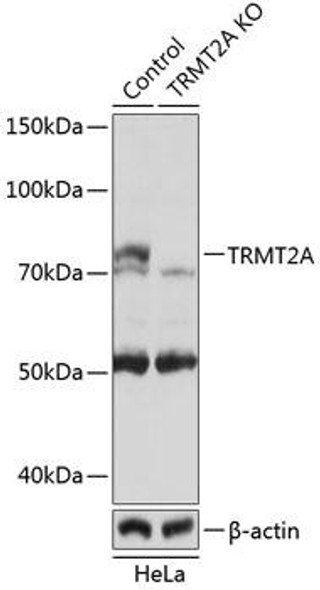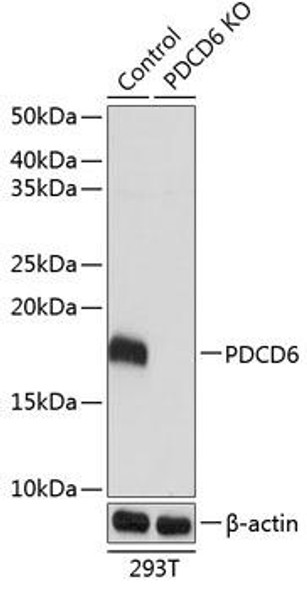Description
Anti-PRDX3 Antibody (CAB18022)[KO Validated]
The PRDX3 Polyclonal Antibody (CAB18022) is a valuable tool for researchers studying PRDX3, a key protein involved in antioxidant defense and cellular redox regulation. This rabbit-derived antibody is highly specific and reactive with human samples, making it ideal for use in Western blot applications. By binding to PRDX3, the antibody enables the detection and analysis of this important protein in various cell types.PRDX3, also known as peroxiredoxin-3, plays a crucial role in protecting cells from oxidative stress and regulating redox signaling pathways.
Its function in maintaining cellular homeostasis makes it a promising target for research in areas such as oxidative stress-related diseases, inflammation, and cancer. Understanding the role of PRDX3 can provide valuable insights into potential therapeutic strategies for these conditions.
| Antibody Name: | Anti-PRDX3 Antibody [KO Validated] |
| Antibody SKU: | CAB18022 |
| Antibody Size: | 20uL, 50uL, 100uL |
| Application: | WB |
| Reactivity: | Human, Mouse |
| Host Species: | Rabbit |
| Immunogen: | Recombinant fusion protein containing a sequence corresponding to amino acids 63-256 of human PRDX3 (NP_006784.1). |
| Application: | WB |
| Recommended Dilution: | WB 1:500 - 1:2000 |
| Reactivity: | Human, Mouse |
| Positive Samples: | HeLa |
| Immunogen: | Recombinant fusion protein containing a sequence corresponding to amino acids 63-256 of human PRDX3 (NP_006784.1). |
| Purification Method: | Affinity purification |
| Storage Buffer: | Store at -20°C. Avoid freeze / thaw cycles. Buffer: PBS with 0.02% sodium azide, 50% glycerol, pH7.3. |
| Isotype: | IgG |
| Sequence: | PAVT QHAP YFKG TAVV NGEF KDLS LDDF KGKY LVLF FYPL DFTF VCPT EIVA FSDK ANEF HDVN CEVV AVSV DSHF SHLA WINT PRKN GGLG HMNI ALLS DLTK QISR DYGV LLEG SGLA LRGL FIID PNGV IKHL SVND LPVG RSVE ETLR LVKA FQYV ETHG EVCP ANWT PDSP TIKP SPAA SKEY FQKV NQ |
| Gene ID: | 10935 |
| Uniprot: | P30048 |
| Cellular Location: | Mitochondrion |
| Calculated MW: | 25kDa/27kDa |
| Observed MW: | 25kDa |
| Synonyms: | PRDX3, AOP-1, AOP1, HBC189, MER5, PRO1748, SP-22, prx-III |
| Background: | This gene encodes a mitochondrial protein with antioxidant function. The protein is similar to the C22 subunit of Salmonella typhimurium alkylhydroperoxide reductase, and it can rescue bacterial resistance to alkylhydroperoxide in E. coli that lack the C22 subunit. The human and mouse genes are highly conserved, and they map to the regions syntenic between mouse and human chromosomes. Sequence comparisons with recently cloned mammalian homologs suggest that these genes consist of a family that is responsible for the regulation of cellular proliferation, differentiation and antioxidant functions. This family member can protect cells from oxidative stress, and it can promote cell survival in prostate cancer. Alternative splicing of this gene results in multiple transcript variants. Related pseudogenes have been identified on chromosomes 1, 3, 13 and 22. |
| UniProt Protein Function: | PRDX3: Involved in redox regulation of the cell. Protects radical-sensitive enzymes from oxidative damage by a radical- generating system. Acts synergistically with MAP3K13 to regulate the activation of NF-kappa-B in the cytosol. Belongs to the AhpC/TSA family. |
| UniProt Protein Details: | Protein type:Oxidoreductase; EC 1.11.1.15 Chromosomal Location of Human Ortholog: 10q25-q26 Cellular Component: mitochondrion; mitochondrial matrix; cytoplasm; early endosome; IkappaB kinase complex; cytosol Molecular Function:protein C-terminus binding; identical protein binding; protein binding; thioredoxin peroxidase activity; caspase inhibitor activity; alkyl hydroperoxide reductase activity; kinase binding; protein kinase binding Biological Process: negative regulation of kinase activity; mitochondrion organization and biogenesis; response to lipopolysaccharide; negative regulation of caspase activity; activation of NF-kappaB transcription factor; response to reactive oxygen species; peptidyl-cysteine oxidation; response to hydrogen peroxide; regulation of mitochondrial membrane potential; hydrogen peroxide catabolic process; positive regulation of cell proliferation; myeloid cell differentiation; response to oxidative stress; negative regulation of apoptosis; maternal placenta development |
| NCBI Summary: | This gene encodes a mitochondrial protein with antioxidant function. The protein is similar to the C22 subunit of Salmonella typhimurium alkylhydroperoxide reductase, and it can rescue bacterial resistance to alkylhydroperoxide in E. coli that lack the C22 subunit. The human and mouse genes are highly conserved, and they map to the regions syntenic between mouse and human chromosomes. Sequence comparisons with recently cloned mammalian homologs suggest that these genes consist of a family that is responsible for the regulation of cellular proliferation, differentiation and antioxidant functions. This family member can protect cells from oxidative stress, and it can promote cell survival in prostate cancer. Alternative splicing of this gene results in multiple transcript variants. Related pseudogenes have been identified on chromosomes 1, 3, 13 and 22. [provided by RefSeq, Oct 2014] |
| UniProt Code: | P30048 |
| NCBI GenInfo Identifier: | 2507171 |
| NCBI Gene ID: | 10935 |
| NCBI Accession: | P30048.3 |
| UniProt Related Accession: | P30048 |
| Molecular Weight: | 26kDa |
| NCBI Full Name: | Thioredoxin-dependent peroxide reductase, mitochondrial |
| NCBI Synonym Full Names: | peroxiredoxin 3 |
| NCBI Official Symbol: | PRDX3 |
| NCBI Official Synonym Symbols: | AOP1; MER5; AOP-1; SP-22; HBC189; PRO1748; prx-III |
| NCBI Protein Information: | thioredoxin-dependent peroxide reductase, mitochondrial |
| UniProt Protein Name: | Thioredoxin-dependent peroxide reductase, mitochondrial |
| UniProt Synonym Protein Names: | Antioxidant protein 1; AOP-1; HBC189; Peroxiredoxin III; Prx-III; Peroxiredoxin-3; Protein MER5 homolog |
| UniProt Gene Name: | PRDX3 |
| UniProt Entry Name: | PRDX3_HUMAN |


![Anti-PRDX3 Antibody [KO Validated] (CAB18022)](https://cdn11.bigcommerce.com/s-h68l9z2lnx/product_images/q/776/A18022_1__30523.jpg)








